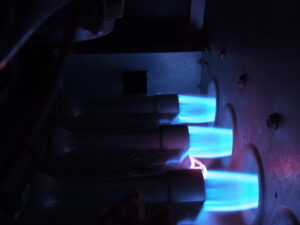
We don’t want to act alarmist about gas furnaces, because they’re generally safe options for home heating. Furnace manufacturers build gas furnaces with safety features and must meet strict standards. If you take care of your furnace with regular maintenance each fall, it has little chance of becoming dangerous.
But we want to bring your attention to a furnace problem that’s the most common cause for a gas furnace becoming unsafe: a cracked heat exchanger. If this happens to your furnace, you’ll either need immediate heating repair in Bryn Mawr, PA or a full furnace replacement.
The Heat Exchanger
Before talking about the danger of a cracked heat exchanger, we need to talk about what the heat exchanger is since many homeowners are unfamiliar with the specific parts of a gas furnace.
The heat exchanger is the part of a gas furnace that applies heat to the air moving through the furnace and into the ventilation system. If you’ve ever seen the interior of your furnace, you’ll notice that a large part of it is taken up by a series of metal containers with clamshell-like edges and a twisty design. This is the heat exchanger, and its job is to transfer the heat from the burners to the air without allowing any of the combustion gases to come into contact with the air. The hot combustion gases from the burners enter the exchanger and cause its metal walls to heat up, and the blower moves air around the exchanger to pick up warmth before going into the ductwork to the rooms.
Cracks in the Exchanger
You can probably guess why cracks in the heat exchanger are potentially dangerous. The combustion gases in the exchanger contain harmful byproducts, such as carbon monoxide. During normal operation, the furnace vents these gases out of the exchanger through a flue, keeping them safely out of the house. A crack, however, can widen as the exchanger’s metal heats up and may allow these gases to enter the air that goes into the rooms of a house.
There are several causes of cracks, but the two most common are…
- Age: The contact between metal and the vapor in the combustion gases over time can lead to corrosion that weakens the heat exchanger. This is a problem that affects furnaces that have been in use far past their standard service lives.
- Poor venting: If the furnace isn’t properly venting the combustion gases through the flue, it will speed up the corrosion and lead to cracks starting earlier.
Repair and Prevention
The best way to catch a cracked heat exchanger is to have technicians inspect your furnace in the fall before it has to go to work. We always look carefully for these cracks. Regular maintenance is also an effective form of prevention since it will ensure the furnace vents correctly.
If you do have a cracked heat exchanger, the best repair is to replace the exchanger. For an older furnace, however, we’ll recommend replacing the entire furnace, which is the best for home safety.
Michall Daimion Heating & Air Conditioning, Inc. has been the Main Line’s Premier Service Provider since 1976. Schedule furnace repair with us as soon as you think there’s a problem. We offer 24-hour emergency service.
